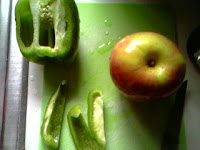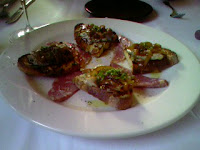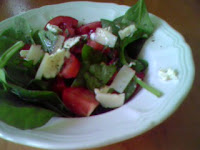Friday, November 27, 2009
Perfect timing
Saturday, October 17, 2009
Meating my life away
 2009, as fast as it's gone, has offered results a long time coming. Maybe I'll call it my reaping year, which—like leap years or full moons—come once every four turns (or, for me, possibly eight or sixteen).
2009, as fast as it's gone, has offered results a long time coming. Maybe I'll call it my reaping year, which—like leap years or full moons—come once every four turns (or, for me, possibly eight or sixteen). Okay, fair enough. I am concerned with my health—reason one to consider changing my diet. But animals—some of my favorite people—and environmental protection are further bait. Bittman enlightened me: Animals raised industrially are done so in the harshest conditions, often in overcrowded lots, sometimes concrete, and fed diets of corn and soy, and even meat, which are nutritionally wrong yet economically sound for farmers. And to keep their stock healthy, they often pump them with antibiotics, which in turn make their way into our bodies, weakening our systems’ receptivity to such medicines. Heart attacks and antibiotic immunity? We truly are what we eat.
But enough about me. And the animals. Let’s consider our land. Fifty percent of U.S. farmland is devoted to corn and soy crops, which aren’t grown to alleviate hunger, but which are pumped into the bodies of cattle, chickens, and pigs—not to mention sugar-saturated grocery aisles full of high-fructose, partially hydrogenated fluff. (After-school snack, anyone?)
These insights were the kickers for me. Among others that Bittman shares:
“It doesn’t take a genius to see that an ever-growing population cannot continue to devote limited resources to produce ever-increasing amounts of meat, which takes roughly ten times more energy to produce than plants. Nor can you possibly be ‘nice’ to animals, or respectful of them, when you’re raising and killing them by the billions.
And it doesn’t take a scientist, either, to know that a handful of peanuts is better for you than a Snickers bar, that food left closer to its natural state is more nutritious than food that has been refined within an inch of its life, and that eating unprecedented quantities of animals who have been drugged and generally mistreated their entire lives isn’t good for you.”
Sobering words. But, all said, this doesn't mean that meat—locally and humanely raised meat—is totally out of my life. I have simply reevaluated the sources of my food and my consumption of it, becoming more aware of my impact on the planet—and its impact on me—one bite at a time.
Saturday, August 1, 2009
A brief history
I'm okay with that.
A history of the past two months, in photographs.






 Sweet-potato Belgian waffle with sorghum syrup
Sweet-potato Belgian waffle with sorghum syrup Saturday, May 23, 2009
Full service
 I was still buzzed from morning java when I headed for afternoon caffeine at Greenville’s Coffee and Crema on South Pleasantburg. I’d recently read about its expertly pulled shots and decorative latté—reconstructions of top-quality beans from Durham, NC's, gifted purveyor, Counter Culture Coffee—and was hoping to find a stand-in for my city cappuccino.
I was still buzzed from morning java when I headed for afternoon caffeine at Greenville’s Coffee and Crema on South Pleasantburg. I’d recently read about its expertly pulled shots and decorative latté—reconstructions of top-quality beans from Durham, NC's, gifted purveyor, Counter Culture Coffee—and was hoping to find a stand-in for my city cappuccino.And then it hit me: These women—entrepreneurs, bakers, coffee mavens—are public servants. And their shop is more than meets the eye: part gallery for local artists, part classroom for nutrition and sustainable foods (everything, from the homemade cakes to the chocolate for the mochas, is all natural. Plus, coffee comes from West End Coffee, bagels from Greenfield’s, milk from Happy Cow Creamery), and part melting pot—classes and cultures converge for fresh coffee.
I often consider the relativity of my interests, my work—how best I can package them to serve. Coffee to a Tea reminds that a food business not only offers culinary and gustatory pleasure: It is a crossroads of diversity, history, information. And that’s what I call exceptional service.
(By the by, I found my cappuccino’s counterpart at Coffee and Crema—whose charming owner serves great conversation and an endless knowledge of the bean, along with fine espresso.)
Saturday, April 11, 2009
Marking time
We've had resplendent weather this April, with a mean storm now and again. Such lovely days make it hard to imagine being anywhere else. Beautiful weather floors me. My senses go wild, and I want to hold on to every waking moment. Such concentration is exhausting. I don't know what it is with me lately, but I've been adamant, downright stubborn, about not letting go: I want to jar everything beautiful (good and bad). I think I've hit my stage of revolt: Time is going too fast!
The other day I received a package from a dear friend. She and I had the pleasure and privilege of studying in Cortona, Italy, for fall semester 2002. During a recent conversation, she mentioned that she was digitizing Cortona photographs and that I should expect a package of prints in the coming weeks.
That stack was more than I bargained for. I was floored by time.
Who knows what latent interests/knowledge we have? I've probably always had a culinary penchant. It wasn't until Cortona, however, that my interest was piqued. Maybe it was the slower pace of life, a focus on mealtime, with its hours-long pace and devotion to courses and conversation. Perhaps it was the bounty of fresh produce, cheeses, olives, chocolate, small markets, specialty shops, one-euro cappuccino. Whatever the reasons, they tapped into that latent love, and I discovered the pleasure of food.
Years later, I understood its importance for marking time. I once read that a man remembered his wine by assigning a different image to its taste. A deep cabernet would evoke dark woods on a snowy night—or something of the sort. My brain works oppositely: Those dumplings? Sheer heaven in June '05. The weather was pristine, and I walked up from Chinatown in my pink tank and cocoa-brown pants.
Looking through those photographs was bittersweet. My friend's keen eye captured moments that escaped my photo-journey, so I was glad to have her records for the gaps. But more than this, I was saddened by the fact that I saw myself in time, in moments that I have forgotten. I was there! I stood there. I looked angry, or hot, or elated, or captivated. How could I not remember? Why didn't such precious time matter?
Maybe it did for a while. But (to be clichéd), everything has its season. Memories, too, have their temporal arcs. They begin, grow, peak, recede, and—eventually—die. I probably should leave the process alone. Let the mind age.
With attention and care, it should only get better by year.
Monday, April 6, 2009
Fresh, direct
The other day, as I was cracking eggs for my first frittata (Blair's first frittata, age 27.8), I had my moment, smack dab in the springtime kitchen. Late-afternoon light through the cracked window, that gorgeous golden light washing the open, peaceful space. The tomato, fragrant rosemary, eggs, the freshly grated Parmesan, buttery cheddar, and grassy brie—so direct, so simple, so fine.
Vegetable Frittata
(Courtesy Julianna Pletcher)

1 cup diced baking potato
1/4 cup water
1 Tbs olive oil or butter
6 scallions (green onions), white and some green parts, thinly sliced
1 cup loosely packed, fresh spinach leaves, coarsely chopped
1/4 cup fresh basil and parsley, chopped (note: I substituted fresh rosemary, chopped, about a tablespoon worth)
6 large eggs
3 Tbs milk
1/4 cup grated Parmesan cheese
Salt and ground pepper, about 1/4 tsp each or to taste
1-2 Roma tomatoes, thinly sliced
2-3 ounces of crumbled goat cheese (note: I used brie and Wisconsin cheddar, but I'm sure that goat cheese would be divine. If you're in the area, pick up yours here.)
Preheat oven to 350 degrees. Place potato and 1/4 cup water in a microwave-safe bowl. Cover with a loose lid and microwave on high for four minutes or until tender, stirring once. Or, boil potatoes on the stovetop until tender. Drain and set aside. Then, heat a medium (10- to 12-inch) cast-iron skillet, or a nonstick, ovenproof skillet. Add oil or butter and green onion. Sauté for 2-3 minutes. Add potatoes, spinach, and herbs and continue to cook for 3-4 minutes. Meanwhile, in a medium bowl, whisk together the eggs, milk, Parmesan, salt and pepper. Turn off the heat. Pour the egg mixture into the skillet and stir gently to combine. Cover the handle with foil if it isn't ovenproof. Place the skillet in the oven and cook for 15-20 minutes until set, then remove it and set the oven temperature to broil. Top the frittata with tomato slices and extra cheese, if desired. Broil for 4-5 minutes, or until the eggs are set and the cheese melts. Cut into six wedges and serve. Could also be served at room temperature. Feel free to incorporate other veggies, like asparagus, bell pepper, onion, swiss chard, zucchini, etc.
Omnivores can throw in sausage, pancetta, or prosciutto. (But why complicate?)
Wednesday, April 1, 2009
Escape (roots)
Keeping a blog has its benefits. Beyond its value as an immediate and low-maintenance way of exchanging ideas, it is forcing me to hone my thoughts and extract them. Among the realizations that I've come upon in recent weeks is instead of pursuing avenues of escape—my most foot-worn being food—I should be as present as possible. Open my eyes and mind to the South's cultural and culinary bounty.
But maybe I shouldn't be so hard on myself. After all, we all are searching—craving enlightening and enlivening experiences different (or what we perceive as different) from our own. Who doesn't appreciate tapas? To be offered myriad delectable options for composing the most tongue-tantalizing experience possible? I want the tapas of my life to be culturally, ethnically, professionally, and personally distinct, daring, dense, and delicious. Escape is okay, necessary even, as long as I remember where I am.
I will start here. And go from there.
Saturday, March 21, 2009
Worth at least 301 words
 Consider the importance of food.
Consider the importance of food.
